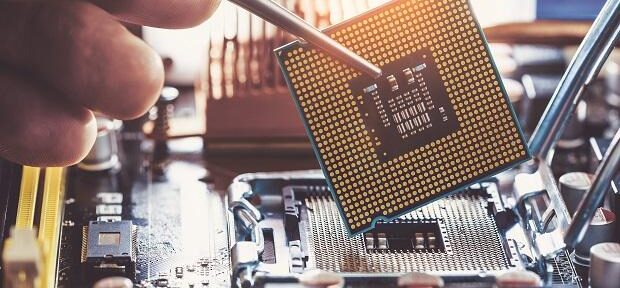Semiconductors, also known as integrated circuits, are the backbone of modern electronics. They are a crucial component that is found in a wide range of devices, including computers, smartphones, appliances, gaming hardware, and medical equipment. With their ability to conduct electricity more than insulators but less than pure conductors, semiconductors play a pivotal role in more than one electronic function.
What are semiconductors?
In simplest terms, semiconductors are materials that possess properties between those of conductors (such as metals) and insulators (such as glass or plastic). The most commonly used semiconductor material is silicon (Si). Unlike conductors, which easily allow the flow of electric current, and insulators, which prevent its flow, semiconductors can conduct electricity under certain conditions but not as freely as conductors.
How do semiconductors work?
The conductivity component of semiconductors can be altered by introducing impurities through a process called “doping.” By adding specific impurities, the semiconductor’s electrical properties can be controlled. There are two main types of semiconductors based on the elements introduced during the doping process:
-
n-type semiconductor: Doped with impurities containing extra electrons, such as phosphorus, arsenic, antimony, or bismuth. These extra electrons make the semiconductor more conductive. -
p-type semiconductor: Doped with impurities containing fewer electrons, such as boron, gallium, or aluminium. These “holes” create vacancies in the crystal lattice, making the semiconductor conductive in the opposite direction.
Applications of semiconductors
Semiconductors have revolutionised the electronics industry and are essential components in a wide range of devices, such as:
-
Microprocessors: The central processing units (CPUs) in computers and other electronic devices are made of semiconductors. Microprocessors perform tasks and execute instructions, making them the “brains” of modern electronics. -
Memory chips: Semiconductors are used in memory chips to store data temporarily, facilitating information exchange and processing. -
Commodity Integrated Circuits: These standardised chips are mass-produced for routine processing purposes and are found in everyday electronic devices. -
Complex System on a Chip (SOC): These chips integrate various functions, combining memory, microprocessors, and other components into a single chip commonly used in smartphones and other consumer electronics. -
Microcontrollers: These specialised semiconductors are used to control electronic devices and embedded systems. -
Transistors: Transistors, a fundamental component of semiconductors, are used for signal amplification and switching in electronic circuits.
Global semiconductor landscape: Key players
Currently, Taiwan Semiconductor Manufacturing Co (TSMC) is the world’s largest memory chip manufacturer, and it has placed Taiwan on the list of the most important regions in the world. Besides TSMC, Taiwan is also home to some of the most advanced chipmaking facilities in the world, including the brand-new 3-nanometer fabs that entered production in the second half of 2022.
In terms of the production of semiconductors and microchips, Japan boasts of the strongest semiconductor ecosystems in the world, with 102 chipmaking facilities operating in the country.
South Korea is the other major exporter of logic and memory chips. The country is home to two of the world’s three largest memory chip manufacturers: SK Hynix and Samsung. The pair collectively controlled roughly two-thirds of the global memory market as of September 2022.
Samsung’s chipmaking divisions also manufacture semiconductors for other companies. Samsung Foundry is one of only two companies in the world (the other being TSMC) that make chips for others with leading-edge process technologies such as 5-nanometer and now 3-nanometer.
Among other major producer centres are the United States, Germany, and China, which maintain a steady supply balance between logic and memory chips.
India: A growing electronic manufacturing hub
Now, India is “rolling out the red carpet” for global semiconductor manufacturers, aiming to establish itself as a prominent industry hub. The government has committed $10 billion in incentives and assistance to encourage local chip manufacturing.
Setting up semiconductor fabrication units or fabs requires significant investments and expertise. India is seeking a collaborative approach, building partnerships with like-minded nations to facilitate sustainable growth in the industry. By leveraging its skilled workforce and fostering innovation, India aims to establish itself as a key player in the semiconductor revolution.
Through the production-linked incentive (PLI) scheme, companies like Vedanta and Taiwan’s Foxconn have pledged multi-billion dollar investments in setting up units to manufacture chips.
USA’s AMD also announced on Friday it will invest around $400 million in India over the next five years, and it will build its largest design centre in the country in Bengaluru. Anil Agarwal, founder and chairman of Vedanta Resources Limited, reiterated his company’s semiconductor manufacturing plant in India.
Strategic advantages: Skilled talent and design excellence
According to a report by The Hindu, India boasts a significant advantage in semiconductor design and intellectual labour. A large portion of semiconductor design engineers worldwide is either Indian or of Indian origin. Companies like Intel and NVIDIA already have large facilities in India with Indian talent working on design problems. This is an advantage that China is losing control over in the face of sanctions and an ageing population.
